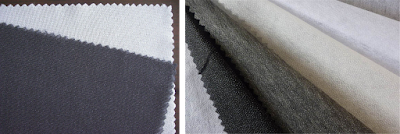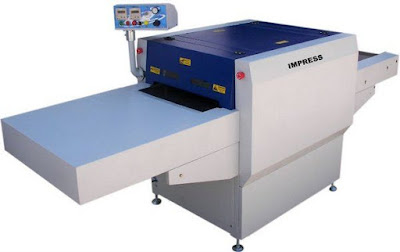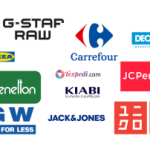Garment Fusing?
Garment Fusing is a process of introducing interlining materials/sheet in-between the parts of the garment. Fusible Interlining sheet is coated with thermoplastic polymer resin and it is used to ensure a fixed shape, good strength and stability of a garment.
How many methods are available for resin coating?
1. Scatter coating: Resin is sprayed on the base fabric by a spray head. Then temperature and pressure are used to fix the resin on the base fabric. The molecular size of the resin varies between 150 to 400 microns. Properties of interlining is not all through uniform in this type of coated interlining, hence this type of interlining is cheaper than others.
2. Dry–dot–coating: Powder of resin is applied on the base fabric in dot form by an engraved roller, then the base fabric is passed through an oven, where due to temperature the resin melts and due to pressure of roller the resin sticks on the base fabric. The number of dots per cm maybe 3 to 12 and the size of resin particles vary from 80 to 200 microns. For fine fabric finer dots and for coarser fabric larger dots are used. Property of this type of interlining is all through uniform.
3. Paste interlining: Resin powder is converted into a paste by the use of chemicals and water. Then the paste is printed on the base fabric. Then by applying temperature water and chemicals are evaporated from the base fabric. Very fine dots are produced by printing technique with resin size 1 to 80 microns. The properties of this type of fused interlining with resin are all through uniform.
4. Film coating: Polymer resin is first melted by the use of temperature and then applied on the base fabric as a very fine film on one side of the fabric. Polyethene as a resin is used for film coating. The flexibility of film-coated interlining is quite less than the others.
5. Emulsion coating: Resin is made as emulsion form with the use of chemicals and water. Then through this emulsion base fabric is passed which picks up the emulsion. By the use of a squeeze roller emulsion take up is controlled. Then the fabric is passed through an oven where the interlining is dried. This type of interlining is very hard after fusing.
Different elements used in the garment industry:
In the garment sewing industry, a variety of elements, tools and equipment are being used. These are essential to make the garments.
Different elements used in the sewing industry | ||
➽Awl/needle ➽Different types of sewing machine ➽Fabric Chalk ➽Local iron ➽Measuring tape ➽Pencil ➽Pointer ➽Pressing machine with vacuum table | ➽Sidebox ➽Sitting chair / stool for operator ➽Steam iron ➽Stitch opener ➽Table for marking ➽Table for matching garments parts ➽Rack | ➽Table for quality inspection ➽Template / finished pattern ➽Tray ➽Trimmer ➽Various attachments like the guide, gauge, jigs, and folder etc. ➽Scissor ➽Sewing threads |
Texpedi.com
Check out these related articles:







